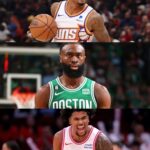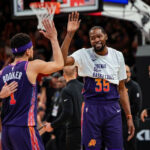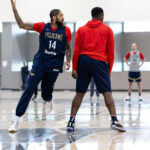Jordan’s Kids Buzzin Yet?
When the Charlotte Hornets were rewarded with the second overall pick in this year’s draft there were only two prospects that they pondered betting on in the long run. Freshman score first swingman Brandon Miller out of Alabama and the powerfully built guard Scoot Henderson from Overtime Elite. This past week, the Hornets inked franchise cornerstone point guard LaMelo Ball a remunerative 5-year, $260 million dollar rookie contract extension. With the 2nd overall pick the Hornets preferred a prospect that’ll inevitably grow alongside Ball in hopes of bringing the franchise some prominence and a return to the postseason certainly is the only way to do so.
Selecting the beyond-gifted Scoot Henderson with the second pick would instantly without a doubt give the Hornets one of the formidable backcourts of the future. Given Scoot’s skill set and ability on the ball, it would more likely take some time for him to adapt to an offense that heavily revolves around LaMelo. If your franchise’s two best players are mostly perimeter dependent let alone guards, there should be a pathway to at least both players being able to play off of each other. How far can an NBA team go long-term with their two best players playing primarily in the same position or operating in the same space? Currently, constituted can these two players be the best two players on a championship team? Can your two best players co-adapt to one another without hindering the other? Do they make others better? That’s ultimately what every GM asks themselves when evaluating all these players. For those specific reasons, that’s what I ultimately believe swung the selection in Brandon Miller’s favor. Miller, a 6’9 score first wing that can create for himself off the bounce simply possesses a more favorable skillset next to Ball. Miller can still be a threat off the ball and gives the Hornets a desperately needed scoring option at the wing position.
Gordon Hayward turns 34 next spring and despite being an overqualified complementary role player at this stage of his career, he hasn’t played in more than 50 games since arriving in Charlotte. Hayward, who’s an expiring free agent in 2024 may be an attractive asset at this upcoming season’s trade deadline to perhaps a team looking to make a playoff push or a contender aiming to deepen their depth. Miles Bridges had a career year in 2021-22 averaging 20 points a game, seven rebounds, and four assists on promising 49/33/80 shooting splits. Bridges who’s finally overcome an injury-plagued and off-the-court ridiculed 2022-23 will return as one of the go-to scorers this upcoming season for Steve Clifford and co. Bridges recently signed a $7.9 million qualifying offer for the 2023-2024 season in hopes of a long-term deal next summer. LaMelo Ball last season only appeared in 36 games due to an on-and-off nagging ankle injury that he eventually fractured back in February, cutting his third season short. Ball in those 36 games was very productive posting 23.3 points, six rebounds, and eight assists a night on miniscule 41/37/83 splits. Ball, one of the most gifted and selfless floor generals in the association, will have the keys to the franchise for the foreseeable future after agreeing to a $260 million rookie max contract extension earlier this month. LaMelo’s health, though, will be the biggest key for the Hornets going forward.
If Hornets GM Mitch Kupchak can find a realistic market to move off quality veterans in Terry Rozier and Gordon Hayward, that’ll help accelerate the franchise’s rebuild. Rozier has three years left on his $96 million extension but even with his shot-making and playmaking ability, the Hornets are in dire need of a bonafide ball-stopper with more size at the position. Rozier has averaged 19.7 points, four rebounds, and four assists on 43/37/83 splits since joining the Hornets in 2019-20. Rozier, who’s played in 50 career playoff games possesses a skillset that a playoff team will at least find valuable in hopes of strengthening their playoff rotation down the road. PJ Washington has been one of the more under-the-radar intriguing free agents this off-season. Initially, Washington was in hopes of seeking a max extension this summer. The rumor mill is swirling that Washington will be signing a qualifying offer of about $8.5 million from the Hornets, which would make him an unrestricted free agent summer of 2024. Washington is a gifted, long defender that can space the floor and should be a very highly prioritized asset going forward because of his versatility on both sides of the floor and how he fits the Hornets’ current age timeline. Outside of PJ Washington, the Hornets don’t possess a marquee defender that can make life hard for opposing star scorers, especially on the perimeter. How can the Hornets find or obtain that specific ideal type of reliable wing/guard defender that can slow down opponents on a nightly basis? Will it be through draft capital? Will they find X players in the trade market with the current assets they have?
Jalen McDaniels was supposed to fill this exact void when the Hornets took him late in the second round of the 2019 NBA draft. While McDaniels frame and athleticism in the frontcourt were valuable he was often limited in the half-court once the tempo of the game slowed down. McDaniels wasn’t exactly an outstanding floor spacer (career 34% 3P shooter) and the Hornets didn’t put the ball in his hands enough to depend on him to grow into a volume shot creator in the half-court. After three seasons spent in the Buzz City, McDaniels was traded at last season’s deadline to the Philadelphia 76ers as a part of a four-team deal and the Hornets received two second-round picks and guard Svi Mykhailiuk. Head coach Steve Clifford has a plethora of young bigs in Mark Williams, Kai Jones, JT Thor, and Nick Richards. The Hornets moved off of Mason Plumlee last season so it’s going to be interesting which of the young bigs will take the next step forward as the key enforcer and interior presence on both sides of the floor. This year’s other first-round pick Nick Smith Jr. out of Arkansas has also displayed his scoring ability from numerous spots on the court at Summer League in Las Vegas. Smith Jr. has a lot of similar scoring traits as previous first-rounder guard James Bouknight. Bouknight hasn’t quite hit the ground running in his first couple of seasons bouncing back and forth from the G-League affiliated Greensboro Hornets but there’s still optimism entering year three he can bring value off the bench and be a part of the Hornets’ future long term. LaMelo Ball’s playmaking intangibles and infinite vision with this many various volume shot creators now back healthy should without a doubt make them one of the more potent offenses in the Eastern Conference. Ball is definitely the most essential component to this ball club and the Hornets are only going to go as far as he goes. The question yet to be answered is whether they’ll be able to get stops down the stretch to contend for a spot in a quietly open Eastern Conference.
Author Profile

Latest entries
 NBAMarch 27, 2024Nass’ Trip Around the Association Vol. 3, Page Fifteen
NBAMarch 27, 2024Nass’ Trip Around the Association Vol. 3, Page Fifteen NBAMarch 8, 2024Nass’ Trip Around the Association Vol. 3, Page Fourteen
NBAMarch 8, 2024Nass’ Trip Around the Association Vol. 3, Page Fourteen NBAJanuary 24, 2024Nass’ Trip Around the Association Vol. 3, page Thirteen
NBAJanuary 24, 2024Nass’ Trip Around the Association Vol. 3, page Thirteen NBADecember 12, 2023Nass’ Trip Around the Association Vol. 3, Page Twelve
NBADecember 12, 2023Nass’ Trip Around the Association Vol. 3, Page Twelve

